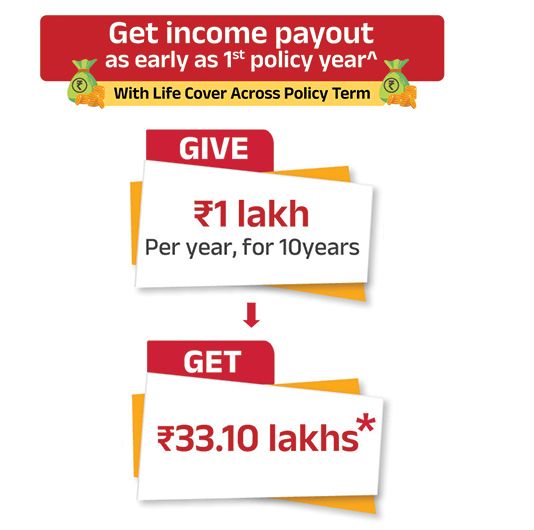Aditya Birla Sun Life Insurance Company Limited
Monthly investment options: Smart ways to invest ₹5K-10K every month

Plan Smarter, Live Better!

Thank you for your details. We will reach out to you shortly.

Currently we are facing some issue. Please try after sometime.


- Table of Contents
Whether you are in your 20s, your 70s or anywhere in-between, you no doubt have a growing list of financial goals that you need to achieve within a given timeframe. Investing, as you may be aware, is the only way to grow your money enough to achieve the goals on your wishlist.
But it's not enough to merely know that you should invest. You also need to figure out how to invest your hard-earned money. The smartest investors choose to invest periodically, like on a monthly basis.
Want to know why? Come, let's find out.
Why invest monthly?
When it comes to investing, you basically have two options - invest a lump sum, or invest periodically. The former may seem like the most logical thing to do, because you have a chunk of money to invest.
But the truth is, investing periodically, like on a monthly or quarterly basis, can have a wide range of benefits that lump sum investments don't offer. Here are the top 3 reasons to invest your money on a monthly basis.
Rupee cost averaging
If you invest a lump sum amount, you will have to keep an eye on the markets to find the right entry point. Because buying at a market high can severely impact your returns. But timing the market is not an easy task.
When you invest monthly, however, you don't need to time the market. A monthly investment plan automatically gives you the benefit of rupee cost averaging - which is essentially a phenomenon where your average investment cost comes down over time, because you invest periodically irrespective of market highs or lows.
Here is an example to help you understand this.
|
Month |
Investment amount (A) |
Cost of each unit of investment (B) |
No. of units purchased (A ÷ B) |
|
January |
Rs. 1,000 |
90 |
11 |
|
February |
Rs. 1,000 |
100 |
10 |
|
March |
Rs. 1,000 |
110 |
9 |
|
April |
Rs. 1,000 |
120 |
8 |
|
May |
Rs. 1,000 |
130 |
7 |
|
June |
Rs. 1,000 |
100 |
10 |
|
July |
Rs. 1,000 |
90 |
11 |
|
August |
Rs. 1,000 |
80 |
12 |
|
September |
Rs. 1,000 |
100 |
10 |
|
October |
Rs. 1,000 |
90 |
11 |
|
November |
Rs. 1,000 |
70 |
14 |
|
December |
Rs. 1,000 |
80 |
12 |
|
Total |
Rs. 12,000 |
|
125 |
|
Average price per unit (Rs. 12,000 ÷ 125 units) |
|
Rs. 96 | |
See how a monthly investment plan helps bring down your average investment cost? Even though you invested at Rs. 100 or higher in several months, your average cost is just Rs. 96. The power of compounding A systematic investment plan also helps you take advantage of compounding - which is simply a technique of wealth accumulation where you earn returns on your returns.
For instance, say you invest Rs. 5,000 each month, at a rate of 10% per annum.
- By the end of the year, you would have invested Rs. 60,000.
- You would have earned Rs. 3,351 by the year end.
- So, your total corpus after one year is Rs. 63,351.
This entire amount will then be invested the next year, resulting in compounded earnings.
Convenience
A savings plan where you invest small amounts monthly is much more convenient than a lump sum investment. For the latter, you have to wait till you have saved up enough. But in a monthly investment plan, you can start investing right away, with as little as Rs. 500 too.
5 smart ways to invest small sums each month
Even if you can only set aside just Rs. 5,000 to Rs. 10,000 each month, there are many ways to invest that sum periodically to achieve your financial goals. Here are some of the top investment avenues for regular investments.
Recurring Deposits
Here are some of the top features of recurring deposits (RDs).
- The minimum amount you can deposit is Rs. 100.
- The investment tenure for RDs ranges from 6 months to 10 years.
- The interest rate varies from 4% to 8%.
- RDs carry very low risk and offer guaranteed# returns.
Savings Plans
A savings plan, also known as an endowment plan, is a kind of life insurance policy that combines the advantages of a life cover and long-term savings. When you purchase a savings plan, you get the benefit of life insurance over the entire policy term. This means that in case of your unfortunate demise during the policy term, your insurance provider will pay out the death benefits guaranteed# under the plan to your nominee.
On the other hand, if you survive the policy term, you will receive the maturity benefits as per the terms and conditions of the policy. This includes loyal additions and bonuses, if any.
To enjoy these benefits, you need to pay a premium to your insurance provider. Based on the frequency of payments, there are three kinds of savings plans, as outlined below.
| Type of savings plan | Period over which the premium is paid |
|
Single premium savings plans | Premium charges are as a lump sum amount at the time of policy purchase |
|
Regular premium savings plans | Premium charges are paid periodically, over the entire policy term |
|
Limited premium savings plans | Premium charges are paid periodically, over a period that is shorter than the policy term |
In regular premium and limited premium plans, you can make your premium payments on a monthly, quarterly, semi-annual or annual basis. With a budget of Rs. 5,000 to Rs. 10,000, you can purchase a savings plan that offers a sizable life cover, you can even enhance your benefits with additional life insurance riders3.
In this manner, you can check off two goals with just one investment - namely protecting your family financially as well as saving up for your future. Also, by splitting up your premium payments over the years, you can enjoy tax benefits² throughout the premium payment term.
Direct Equity
If you are an aggressive investor who can afford to take on more risk, you can also use your monthly investment budget to invest in direct equity. You need a demat account and a trading account to buy or sell shares in the stock market. Once you've opened these accounts, you can start investing in the stocks of your choice on a monthly basis.
Bear in mind though, that this kind of approach requires a great deal of research and understanding of how the stock market functions. If you are a seasoned investor, this approach may work for you. But if you are just a beginner, or if you prefer to leave this to the experts, you can choose to invest in the stock market via mutual funds, as we'll see in the section below.
Mutual funds
Mutual funds are investment products that pool together money from different investors and use the funds to purchase different assets like bonds, stocks, money market instruments or even gold.
Based on the kind of assets they invest in, there are different kinds of mutual funds available in the market today, such as -
- Equity mutual funds
- Fixed income or debt mutual funds
- Liquid or money market funds
- Balanced funds
- Hybrid funds
- Gilt funds
You can easily invest in these funds on a regular basis with a Systematic Investment Plan (SIP). This is a monthly investment plan where you can invest small sums in the funds of your choice regularly. So, with a budget of Rs. 5,000 to Rs. 10,000, you can diversify your portfolio to include different mutual funds too, like debt and equity, thereby spreading out the risk.
Unit Linked Insurance Plans (ULIPs)
ULIPs1 are life insurance plans that give you the advantage of insurance and investment under one policy. Like savings plans, ULIPs also have an insurance component that protects your nominee financially in case of your demise.
But in addition to this life cover, ULIPs allow you to invest regularly in different asset classes via equity funds, debt funds and hybrid funds. You can even switch the funds you invest in during the policy term, based on your changing goals and risk profile. At the end of the policy term, you will receive the fund value as maturity benefits.
The premiums for ULIPs may be slightly higher than the premiums for savings plans, but they can easily fit into a budget of Rs. 5,000 to Rs. 10,000 a month.
Conclusion
There are several smart ways to invest your money in a disciplined manner each month. All you need to do is pick your investment options to get started with your SIP investment plan or your monthly investment plan. Even if you are unable to direct Rs. 5,000 or more to your savings right now, you can begin your journey with a lower amount too. The important thing is to get started. You can always step up your investment budget later, when your financial situation improves.
Thanks for reaching out. We will reach out to you shortly.
Thanks for reaching out. Currently we are facing some issue.
Get immediate income payout after 1 day of policy issuance^
ABSLI Nishchit Aayush Plan
Guaranteed# Income
Life Cover across policy term
Lumpsum Benefit at policy maturity.
Get:
₹33.74 lakhs~
Pay:
₹10K/month for 10 years
Most Popular Calculator
Guaranteed returns after a month¹
1In the Unit Linked Policy, the investment risk in the investment portfolio is borne by the Policyholder.
2Tax benefits are subject to changes in tax laws. Kindly consult your financial advisor for more details.
3Riders offer additional benefits that are not included in the base policy at a nominal additional premium. There are exclusions attached to the riders. Please refer prospectus for more details.
ADV/4/22-23/103







